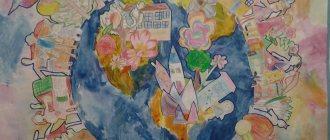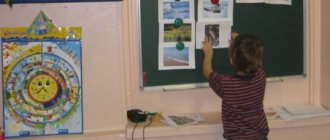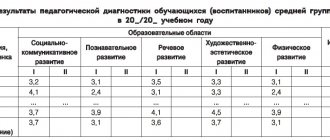Looking at subject pictures
⇐ PreviousPage 4 of 9Next ⇒
(Manual 1 , Fig. 1-12 [1] )
Teach the child to establish the similarity of an object with its image, recognize, show with a finger the named object and individual details, and present the named picture to an adult. Expand your active vocabulary (dog, hammer, horse, watch, goose, ball, house, pipe, rattle, bell, girl, bunny...)
If necessary, show the child a new picture when relating it to a familiar toy. In the plan, indicate the pictures with which the work is being carried out. You can increase the number of pictures in one lesson from 3-4 to 6-8.
Let's wash ourselves
Clarify the understanding of words denoting parts of the body (arms, legs, head),
parts of the face
(mouth, eyes, ears);
household and game action
(washing).
15. Find someone else (with toys)
Teach the child to find in a specially prepared situation toys that have the same verbal designation, but differ in external properties; name toys.
Material.
Two homogeneous objects that differ from each other in some way; an object similar to one of them on this basis, and a control object. Task options:
a) 2 different cows, a goat, a car;
b) 2 different chickens, a rooster, a horse;
c) 2 different pipes, a stick, a drum;
d) 2 different ducks, a goose, a clock;
e) 2 different horses, a cow, a bear;
e) 2 different cats, a dog, a doll.
Questions:
Where is the horse? Where is the other horse? Where's the cow? Where's the bear? What is this? and so on.
16. Examination of paired pictures (guide 1, Fig. 13-32)
Teach your child to find pictures that have the same verbal designation, but differ in external properties. Expand the active dictionary.
Options:
a) 2 different goats, a bull, an iron;
b) 2 different dogs, a bear, a bunny;
c) 2 different cockerels, a horse, a matryoshka;
d) 2 different sticks, balalaika, pyramid;
e) 2 different cats, a drake, a ball.
17. Examination of pictures depicting simple familiar actions (eats, sleeps, bathes, walks, eats, cries, etc.; manual 2, Fig. 1-16)
Teach the child to recognize the action indicated by the word in the picture; indicate this action with a word, gesture, phrase, taking into account the child’s speech capabilities. Lead the child to understand the question “What does it do?” »
a) Different objects and different actions: “The dog is eating”, “Lala is sleeping”, “The bear is walking”,
and others available in the group. Indicate in the plan the pictures with which you are working.
b) Identical actions, different objects: “The dog is eating”, “The goat is eating”, “Lala is eating”
and so on. - sleeps, walks, sits, bathes, rides - with each action there are different characters.
c) Identical objects, different actions: “Lala is sleeping”, “Lala is bathing”, “Lala is eating”,
and others - a dog, a bunny, a bear, a pussy - perform different actions.
The record should indicate not only the child’s understanding of the named actions and the question “What does...?”,
but also what the child’s speech activity is.
18. Examination of simple plot pictures (guide 2, Fig. 17-22)
Interaction of two persons: “A girl bathes a doll”, “A girl feeds a doll”, “A girl sledding a doll” and other pictures available in the group. When choosing pictures, reflect seasonality. Teach the child to see the plot of the picture, i.e. recognize familiar characters and the actions they perform. Form speech consisting of simple common sentences. Learning to answer questions based on the contents of pictures is not monosyllabic, but complete.
Questions:
"Where…? Who is this? The name of? What is this? What is he doing? And you…?"
19. Examination of plot pictures of more complex content (from the series “Good and Bad”; manual 2, Fig. 23-30)
Teach your child to recognize a boy and a girl in pictures; answer fully, in detail.
Questions.
Where is the boy? Where is the girl? Where is the girl's dress and pigtail? Where are the boy's trousers and shirt? Who is this? Where does the boy give the girl an apple? Where does the boy not give the girl toys? What is the boy doing? And you…? and so on.
Story without showing
Teach the child to listen to a short story about events that happened in his experience without visual accompaniment, and to answer questions.
Example of a story. Part I:
“Once upon a time there was a girl Mashenka. Mashenka went for a walk. I put on a hat, coat, boots. She went down the stairs, opened the door and went out into the street...”
Questions:
“Who went outside for a walk? What did Mashenka wear?”
Part II of the story:
“Children were walking on the street. Suddenly a dog jumped out and barked at Masha: “Aw-aw.” Mashenka was scared and crying. And the aunt said: “Don’t be afraid, Mashenka, the dog doesn’t bite.” The dog ran away. Masha didn’t cry anymore, she went for a walk with the kids.”
Questions:
“Who scared Masha on the street? Who barked? What did auntie say to Masha?”
21. What toy do you like (guide 1, Fig. 33-42)
Activate the dictionary on the topic “Toys”.
Clarify the concept of the main action with toys.
Lead the child to understand and name the general word “Toys”.
Learn to answer questions in full sentences.
Questions:
“Which toy do you like? What toys do we have? What do you do with toys? What one word can you use to describe all this?
22. Find out and name vegetables (guide 1, Fig. 43-54)
Introduce your child to natural vegetables and their images in pictures. Insert the names of individual vegetables into the child’s active dictionary. Give an idea about the main actions performed with them, about the place where vegetables are grown. Specify the general word “vegetables”. Continue work on developing phrasal speech, improving word structure, and the phonetic aspect of speech. If in the section “Development of active speech” work has begun on the formation of the correct syllabic structure of the word, get the child to pronounce the first syllables when naming vegetables, maintaining the rhythmic-syllabic composition of the word.
Questions and tasks:
“Show me where... What is this? Where do carrots, cucumbers, onions grow...? What is one word to describe this? What do we do with vegetables?
23. What is missing (based on the topic “Vegetables”; manual 1, Fig. 43-54)
Develop attention and memory. Get answers in full phrases, using the word “No” or the combination “Not.” Make sure you use the words correctly. (First, one is removed from two pictures, then from three, from four.)
24. Family. People (Manual 1, Fig. 55-61)
Expand and activate the vocabulary on the topic “Family”: “Mom, dad, grandfather, grandmother, son, daughter; sits, stands, reads, jumps; big, old, small”, etc. Form a generalizing word “People”. Continue work on developing phrasal speech.
Questions:
"Where is Dad? Where's mom? Who is this? Who's sitting? and so on. What does grandpa (grandmother, dad, mom...) do? Who is big? Who is small (big, small)? Which grandfather (grandmother, granddaughter...)? What one word can you call them?”
25. Who eats what (Manual 1, Fig. 62-69)
Clarify the child’s understanding of who eats what. Activate verbs in speech: “Lapping, gnawing, pecking.” Form generalizing concepts: “Birds, animals.” Teach your child to give a complete answer.
Questions:
“Who is this (dog, chicken, cat)? Who gnaws (can gnaw)? Who is lapping (pecking)? What does a dog chew on a bone with? Who else has sharp teeth? Who else is gnawing? What does the chicken eat? Who else has a beak? Who else is biting? How does a cat lap? What does a dog (chicken, cat) like?
Task options:
a) classification: “Who has teeth, who has a beak.”
b) eliminating the 4th extra.
26. Examination of illustrations for the nursery rhyme “Here people are sleeping” (guide 2, Fig. 31-38)
Help the child remember the names of the characters that appear in the text, where which of them sleeps. Form generalizing concepts “People, Animals”. Continue working on the phrase. Learn to use the preposition “On” in your answers.
Questions:
"Who is this? (Grandmother, grandfather, people.) What are people doing? What kind of people sleep? What are the animals doing? What animals sleep? Where do foxes (bunnies, birds...) sleep? What will birds (animals, ducks) do when they sleep? Who flies (swims, runs)?
Task options:
a) classification: “People, animals, birds.”
b) eliminating the 4th extra.
27. Good and bad (manual 2, Fig. 23-30)
Clarify the concepts of “good and bad.” Teach children to characterize the actions depicted in the pictures, comparing them with their own actions and the actions of other children. Activate adjectives in speech: “kind, neat, sloppy, greedy, pugnacious.” Practice answering questions of a cause-and-effect nature.
Questions:
“What is the boy doing? Can this be done? How is the boy doing? Why is this boy called kind? and so on. And you…?"
28. Transport (Manual 1, Fig. 70-81)
Learn to distinguish by appearance and name a truck and a passenger car, a bus, a tram, an airplane, a boat, a steamship, a tractor, a train, a trolleybus, a bicycle, a motorcycle; show and name parts of the car (cabin, steering wheel, body, wheels, windows). Give an idea of the purpose of each type of transport and the nature of their movement. Learn to answer questions in full sentences. (To get acquainted with various types of transport, make extensive use of opportunities for walks outside the child’s home, toys, pictures).
Questions:
"What is this? Where? What kind of car is this? What is he doing? What do they fly on? What are they driving on the road? What do they float on? What flies (swims, rides on the road, rides on rails)?”
29. Clothes, shoes, hats (Manual 1, Fig. 82-114)
Clarify the child’s understanding of the purpose of items of clothing, shoes, and hats. Practice grouping objects according to their purpose. Expand the vocabulary through generalizing concepts “Clothes, shoes, hats” and their types. (Widely use the possibilities of routine processes, natural things, didactic dolls, pictures.)
Questions:
"What is this? Where do we put it on? What word can be used to describe all this? Why did you put it on top (in the middle, down)?”
30. Dishes (guide 1, fig. 115-124)
Activate the child’s active and passive vocabulary on the topic “Utensils.”
Specify the general word. Give an idea of the purpose of certain types of utensils.
Questions:
“What did we put on the table? What one word can you use to describe all this? What do we do with the cup (plate...)?”
31. Let's arrange a room for the doll (guide 1, fig. 125-131)
Teach your child to distinguish and name pieces of furniture, talk about their purpose. Exercise in the use and understanding of the general word “Furniture”.
Activate in speech the verbs
“Lie down, sit”
in the imperative mood (lie down, sit down), the prepositions
“On”, “In”.
To get acquainted with pieces of furniture, use the environment, doll corner, pictures, and constructive activities.
Questions:
“What should we put in Katya’s room? Why does Katya need a closet (bed, chair, table, sofa...)? Where is your bed? Where is our table...? Where else? Ask Katya to lie down in bed (sit on a chair). Where is Katya sitting (lying)? Where should we put the clothes? (let's put the dishes)? What kind of furniture do we have in our room? What one word can you use to describe all this?
32. What can be ironed, what can be cut with a knife (guide 1, Fig. 132-141)
Introduce the child to the purpose of objects (iron, knife).
Teach your child to group objects (pictures) according to their qualities, explaining your actions.
Activate the names of objects and their qualities in speech. (You can take pictures from the series “clothing”, “vegetables”.)
Sample:
"This dress. The dress is ironed. This is cheese. Cheese is cut with a knife,” etc.
33. What is missing (based on the topics “Clothes”, “Shoes”, “Hats”; manual 1, Fig. 82-114)
Goal see lesson no. 23.
Where to put what
Learn to group familiar objects according to common characteristics (dishes, clothes, vegetables). Lead the child to the ability to exclude an object that does not fit into the group.
Sample:
“This is a coat. We put on our coats. These are clothes. We put the clothes in the closet. This is a plate. We eat from the plate. This is dishes. We place the dishes on a tray. This is a carrot. We eat carrots. Carrot is a vegetable. We collect vegetables in a basket.”
Questions:
"What is this? What do we do with her (him)? Where should I put it? What is on the tray (in the basket, in the closet)? What item did Dunno put in extra? What doesn't work? Why?"
35. Pets (Manual 1, Fig. 142-149)
Teach your child words for the names of pets. Specify animal body parts (horns, hooves, mane, tail, paws, teeth, etc.),
features of appearance
(fur, bristles, etc.)
36. Who else came (manual 1, Fig. 142-149)
Develop visual memory, cultivate observation skills. Develop speech, activate vocabulary on the topic “Pets”.
Questions:
"Who is this? Who else came? (after the child closes his eyes, then opens them).”
37. Who eats what (manual 1, Fig. 142-149)
Clarify the child’s understanding of who, what and how he eats. Expand your vocabulary on the topic “Pets.” Teach your child to answer questions using sentences with homogeneous members.
Sample:
“The cow is chewing grass. A horse chews grass (sheep, pig, goat). The dog chews on a bone. The cat laps up the milk."
Questions:
“How does a cow (horse, goat...) eat? Who else chews grass?
38. Who does what (Manual 1, Fig. 142-149)
Activate the words in the child’s speech: “Butts, scratches, snorts, purrs, meows, grunts, neighs, bleats, moos.”
Make sentences with them.
Questions:
“Who has the horns? Who's butting? Who has scratchy claws on their paws? Who scratches? How does a cow moo? What is she doing?" and so on.
⇐ Previous4Next ⇒
Recommended pages:
Preparatory group. Senior preschool age. Children 6-7 years old
Summary of educational activities for speech development with children 6–7 years old. Compiling a story based on the painting “Autumn” Essay with children 5 – 7 years old “Autumn Day”
Tasks.
To develop children’s ability to independently compose a narrative story based on a picture , adhering to the plan.
Continue to enrich children's understanding of seasonal changes in nature in the fall. Develop the emotional sphere... Compiling a story based on the painting “Children of the North” in a preparatory group for school Compiling a story based on the painting “Children of the North”
.
Goal: Continue to teach children to independently compose a coherent text of 4–5 sentences, without repeating the content of their comrades’ stories . Give knowledge about the nature of the tundra. To introduce children to the life of the northern region. Cultivate respect for...






